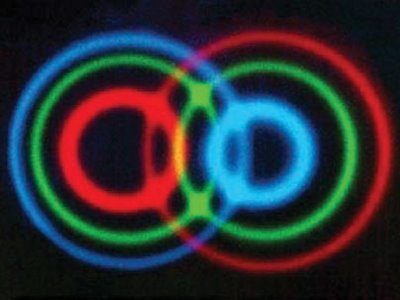ATCA: Quantum Entanglement
London, UK - 15th September 2009, 22:42 GMT
Dear ATCA Open & Philanthropia Friends
[Please note that the views presented by individual contributors are not necessarily representative of the views of ATCA, which is neutral. ATCA conducts collective Socratic dialogue on global opportunities and threats.]
Quantum Entanglement is at the heart of understanding how significant events across the universe operate at the macro- and micro- level in split-second synchronised unison despite considerable distance between them. Quantum Entanglement suggests that information is exchanged faster between QE particles than the speed of light, which was deemed impossible per Einstein's special theory of relativity.
 Quantum Entanglement
Quantum Entanglement
Quantum Entanglement seems to throw out the whole notion of cause and effect, as we know it! It is possible for a particle to interact with another particle in such a way that the quantum states of the two particles form a single entangled state. The definition of an entangled state is that it is not entirely independent of the other's state. Its state is dependent on another's state in some way. Given this dependency, it is a mistake to consider either state in isolation from the other. Rather we should combine the states and treat the result as a single, entangled state.
In the early 1930s, Einstein had problems with the whole of quantum physics, which is ironic given that it was partially based on his Nobel Prize winning paper on the photoelectric effect. What he didn’t like was the way quantum particles don’t have fixed values for their properties until they are observed. Why? Einstein couldn’t relate to a universe where probability ruled! That’s why he famously said that "Der Herrgott würfelt nicht!" or "The Lord doesn’t play dice!" An even better quote, less well known, was when he said: “I find the idea quite intolerable that an electron exposed to radiation should choose of its own free will, not only its moment to jump off, but also its direction. In that case, I would rather be a cobbler, or even an employee in a gaming house, than a physicist!”
Einstein believed that underneath these mathematical probabilities were fixed, hidden realities that we just couldn’t see. That was why he, Podolsky and Rosen dreamed up the idea of what we now call "Quantum Entanglement" in 1935. It was to show that either quantum theory was incomplete, because it said there was no hidden information, or it was possible to instantly influence something at a distance. As that seemed incredible, he thought it showed that quantum theory was incorrect the way it had been presented with probabilistic mathematics. Quantum entanglement is at the heart of the EPR Paradox developed in 1935. This interconnection leads to non-classical correlations between observable physical properties of remote systems, often referred to as nonlocal correlations.
It did take a long time to prove that Quantum Entanglement truly existed. It wasn’t until the 1980s that it was clearly demonstrated. But it has been shown without doubt that this is the case. Therefore, Quantum Entanglement is a property of a quantum mechanical state of a system of two or more objects in which the quantum states of the constituting objects are linked together so that one object can no longer be adequately described without full mention of its counterpart — even if the individual objects are spatially separated in a space like manner across relatively large distances.
When pairs of particles are generated by the decay of other particles, naturally or through induced collision such as at CERN or Fermi Labs, these pairs may be termed "entangled", in that such pairs often necessarily have linked and opposite qualities, ie of spin or charge. The assumption that measurement in effect "creates" the state of the measured quality goes back to the arguments of, among others: Schrödinger and Einstein, Podolsky and Rosen concerning Heisenberg's uncertainty principle and its relation to observation. Quantum Entanglement does underline the fact that quantum particles really do only have a range of probabilities on the values of their properties rather than fixed values. And while it seems to contradict Einstein’s theory of special relativity, which says nothing can travel faster than light, it’s increasingly likely that entanglement challenges our ideas of what space and time really mean!
As Einstein also said, "Raffiniert ist der Herrgott, aber boshaft ist er nicht!" or "The Lord is subtle, but he is not malicious!"
The 100th image added to the "E8 Album" within the HQR initiative is of Quantum Entanglement! Visit here to view the image and to contribute to the Socratic dialogue. The "E8 Album" photos at are visual intersections of Spirituality, Science, Art and Sustainability! Feel free to share the images by clicking share or you can tag yourself!
[ENDS]
We welcome your thoughts, observations and views. To reflect further on this subject and others, please respond within Twitter, Facebook and LinkedIn's ATCA Open and related discussion platform of HQR. Should you wish to connect directly with real time Twitter feeds, please click as appropriate:
. ATCA Open
. @G140
. mi2g Intelligence Unit
. Open HQR
. DK Matai
Best wishes

